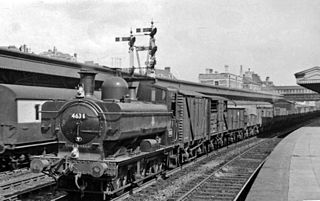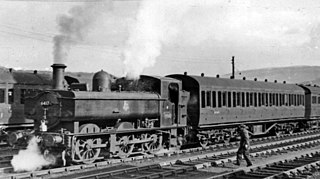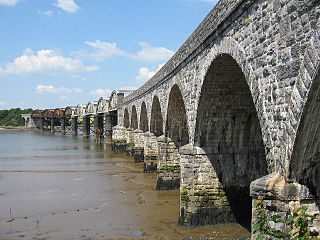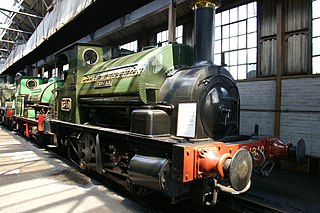| GWR No. 1334, 1335, 1336 | |||||||||||||||||||||||
|---|---|---|---|---|---|---|---|---|---|---|---|---|---|---|---|---|---|---|---|---|---|---|---|
 | |||||||||||||||||||||||
| |||||||||||||||||||||||
| |||||||||||||||||||||||
| |||||||||||||||||||||||
| |||||||||||||||||||||||
GWR No. 1334, and sister locomotives 1335 and 1336, were 2-4-0 steam locomotives which the Great Western Railway inherited from the Midland and South Western Junction Railway. [1]
| GWR No. 1334, 1335, 1336 | |||||||||||||||||||||||
|---|---|---|---|---|---|---|---|---|---|---|---|---|---|---|---|---|---|---|---|---|---|---|---|
 | |||||||||||||||||||||||
| |||||||||||||||||||||||
| |||||||||||||||||||||||
| |||||||||||||||||||||||
| |||||||||||||||||||||||
GWR No. 1334, and sister locomotives 1335 and 1336, were 2-4-0 steam locomotives which the Great Western Railway inherited from the Midland and South Western Junction Railway. [1]
The locomotives had been numbered 10, 11 and 12 by the M&SWJR. [2] They were re-boilered by the GWR and they were the only M&SWJR locomotives to survive into British Railways ownership in 1948.
The locomotives were withdrawn as follows. [3] None is preserved.
| Number | Shed code | Date withdrawn |
|---|---|---|
| 1334 | 81E Didcot | 30 September 1952 |
| 1335 | 81D Reading | 30 September 1952 |
| 1336 | 81D Reading | 31 March 1954 |
A 4 mm scale kit is available from Nu-Cast

The Great Western Railway 4000 or Star were a class of 4-cylinder 4-6-0 passenger steam locomotives designed by George Jackson Churchward for the Great Western Railway (GWR) in 1906 and introduced from early 1907. The prototype was built as a 4-4-2 Atlantic. They proved to be a successful design which handled the heaviest long-distance express trains, reaching top speeds of 90 mph (145 km/h), and established the design principles for GWR 4-cylinder classes over the next twenty-five years.

The 4073 or Castle Class are 4-6-0 steam locomotives of the Great Western Railway, built between 1923 and 1950. They were designed by the railway's Chief Mechanical Engineer, Charles Collett, for working the company's express passenger trains. They could reach speeds of up to 100 mph (160 km/h).

The Great Bear, number 111, was a locomotive of the Great Western Railway. It was the first 4-6-2 (Pacific) locomotive used on a railway in Great Britain, and the only one of its type built by the GWR.

Woodham Brothers Ltd is a trading business, based mainly around activities and premises located within Barry Docks, in Barry, South Wales. It is noted globally for its 1960s activity as a scrapyard, where 297 withdrawn British Railways steam locomotives were sent, from which 213 were rescued for the developing railway preservation movement.

George Jackson Churchward was an English railway engineer, and was chief mechanical engineer of the Great Western Railway (GWR) in the United Kingdom from 1902 to 1922.

The first Locomotives of the Great Western Railway (GWR) were specified by Isambard Kingdom Brunel but Daniel Gooch was soon appointed as the railway's Locomotive Superintendent. He designed several different 7 ft 1⁄4 in broad gauge types for the growing railway, such as the Firefly and later Iron Duke Class 2-2-2s. In 1864 Gooch was succeeded by Joseph Armstrong who brought his standard gauge experience to the workshops at Swindon. To replace some of the earlier locomotives, he put broad gauge wheels on his standard gauge locomotives and from this time on all locomotives were given numbers, including the broad gauge ones that had previously carried just names.

The Great Western Railway 2900 Class or Saint Class, which was built by the Great Western Railway's Swindon Works, incorporated several series of 2-cylinder passenger steam locomotives designed by George Jackson Churchward and built between 1902 and 1913 with differences in the dimensions. The majority of these were built as 4-6-0 locomotives; but thirteen examples were built as 4-4-2. They proved to be a highly successful class which established the design principles for GWR 2-cylinder classes over the next fifty years, and influenced similar classes on other British railways.

The Great Western Railway Iron Duke Class 4-2-2 was a class of 7 ft 1⁄4 in broad gauge steam locomotives for express passenger train work.

The Great Western Railway 4900 Class or Hall Class is a class of 4-6-0 mixed-traffic steam locomotives designed by Charles Collett for the Great Western Railway. A total of 259 were built at Swindon Works, numbered 4900–4999, 5900–5999 and 6900–6958. The LMS Stanier Class 5 4-6-0 and LNER Thompson Class B1 both drew heavily on design features of the Hall Class. After nationalisation in 1948, British Railways gave them the power classification 5MT.

The Great Western Railway (GWR) 4200 Class is a class of 2-8-0T steam locomotives.

The GWR 5700 Class is a class of 0-6-0PT steam locomotive built by the Great Western Railway (GWR) and British Railways (BR) between 1929 and 1950. With 863 built, they were the most prolific class of the GWR, and one of the most numerous classes of British steam locomotive.

The GWR 1400 Class is a class of steam locomotive designed by the Great Western Railway for branch line passenger work. It was originally classified as the 4800 Class when introduced in 1932, and renumbered in 1946.

The Great Western Railway (GWR) 6400 Class is a class of 0-6-0 pannier tank steam locomotive introduced by Charles Collett in 1932. All 40 examples were 'auto-fitted' – equipped with the remote-control equipment needed for working autotrains.

The Plymouth, Devonport and South Western Junction Railway (PD&SWJR) was an English railway company. It constructed a main line railway between Lydford and Devonport, in Devon, England, enabling the London and South Western Railway (LSWR) to reach Plymouth more conveniently than before.

The Great Western Railway (GWR) 4700 Class was a class of nine 2-8-0 steam locomotives, designed by George Jackson Churchward. They were introduced in 1919 for heavy mixed-traffic work. Although primarily designed for fast freight, the class also sometimes hauled passenger trains, notably heavy holiday expresses in the summer months. They were unofficially nicknamed "Night Owls" because they were primarily designed to haul goods during the night and they could be seen simmering in the daylight, awaiting their nocturnal duties.

Cirencester Watermoor railway station was on the Midland and South Western Junction Railway (M&SWJR) at Cirencester in Gloucestershire. The station opened on 18 December 1883, as the terminus of the Swindon and Cheltenham Extension Railway line from Swindon Town. That line then amalgamated with the Swindon, Marlborough and Andover Railway to form the M&SWJR. Cirencester became a through-station in 1891, with the opening of the northern extension of the line between Cirencester and the junction at Andoversford with the Great Western Railway (GWR)'s Cheltenham Lansdown to Banbury line, which had opened in 1881.

Swindon Town railway station was on the Midland and South Western Junction Railway at Swindon in Wiltshire, England. The station was open from 1881 to 1972, and was sited in the Old Town area about one-and-a-half miles from the Great Western Railway's Swindon Junction.

The GWR 0-4-0ST steam locomotives were acquired by the Great Western Railway at the 1923 grouping. They came from small railways and from contractors. Some of them survived into British Railways ownership in 1948 and a few are preserved.

The Midland and South Western Junction Railway (M&SWJR) was an independent railway built to form a north–south link between the Midland Railway and the London and South Western Railway in England, allowing the Midland and other companies' trains to reach the port of Southampton. The M&SWJR was formed in 1884 from the amalgamation of the Swindon, Marlborough and Andover Railway and the Swindon and Cheltenham Extension Railway. The line was absorbed by the Great Western Railway at the 1923 grouping of the railways, and became part of British Railways on nationalisation in 1948. The railway closed to passengers in 1961, and to goods between 1964 and 1970. A small part of it has been reopened as the heritage Swindon and Cricklade Railway.

From 1920, the cab side of Great Western Railway (GWR) steam locomotives bore a letter on a coloured disc, which enabled staff to quickly assess the capabilities of locomotives without the need to check tables of data. The letter showed the power classification, and the coloured disc showed the weight restriction. This system continued after the GWR became the Western Region of British Railways.